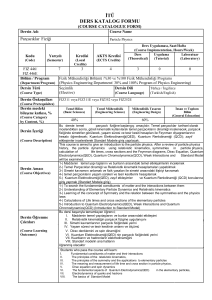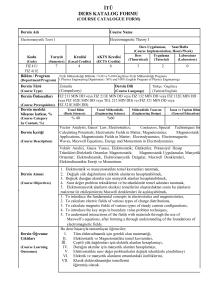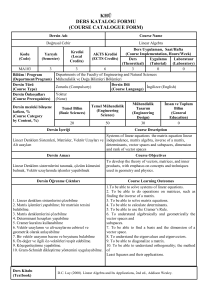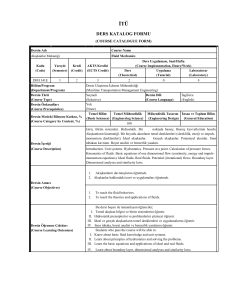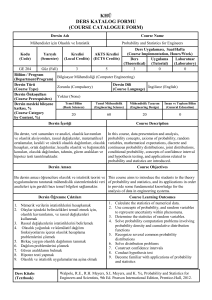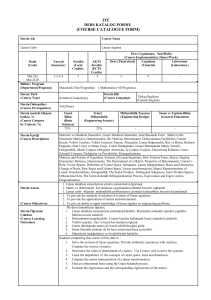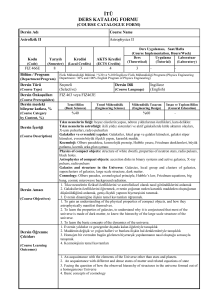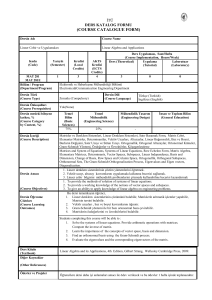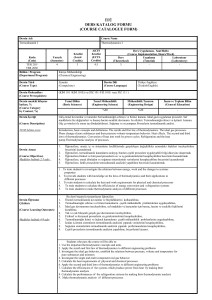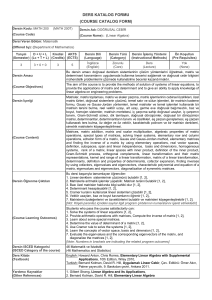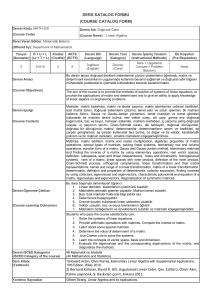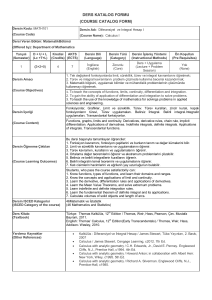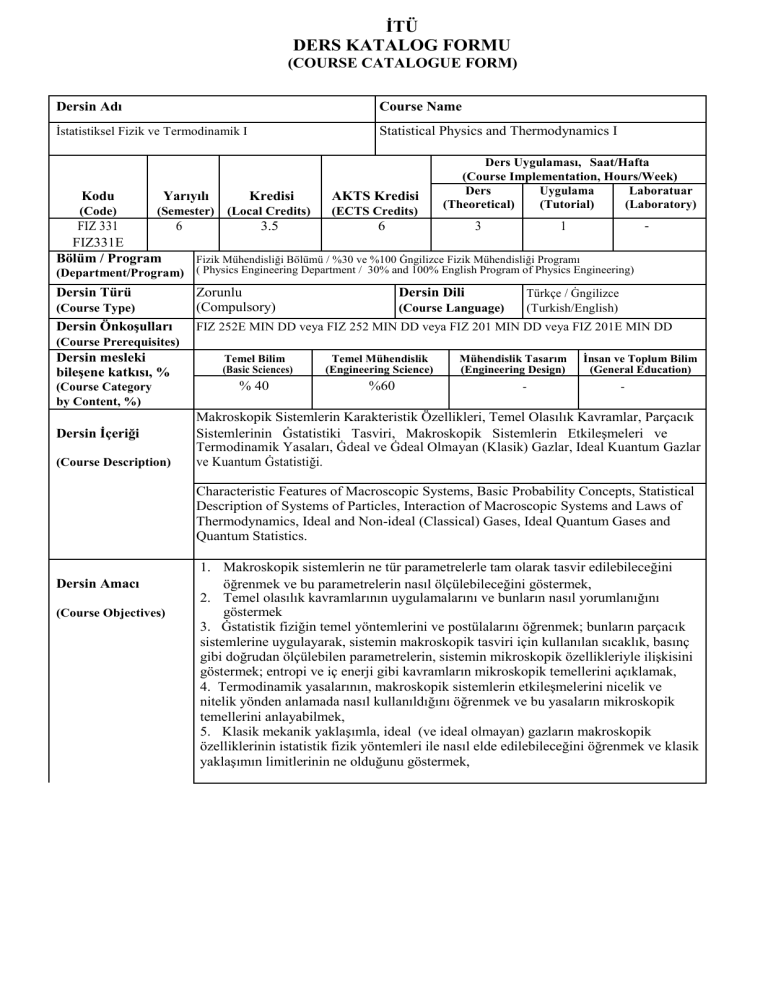
İTÜ
DERS KATALOG FORMU
(COURSE CATALOGUE FORM)
Dersin Adı
Course Name
İstatistiksel Fizik ve Termodinamik I
Statistical Physics and Thermodynamics I
Kodu
(Code)
Yarıyılı
Kredisi
(Semester) (Local Credits)
AKTS Kredisi
(ECTS Credits)
Ders Uygulaması, Saat/Hafta
(Course Implementation, Hours/Week)
Ders
Uygulama
Laboratuar
(Theoretical)
(Tutorial)
(Laboratory)
FIZ 331
6
3.5
6
3
1
FIZ331E
Bölüm / Program
Fizik Mühendisliği Bölümü / %30 ve %100 Ġngilizce Fizik Mühendisliği Programı
-
(Department/Program) ( Physics Engineering Department / 30% and 100% English Program of Physics Engineering)
Dersin Türü
Dersin Dili
Türkçe / Ġngilizce
(Turkish/English)
(Course Type)
Zorunlu
(Compulsory)
Dersin Önkoşulları
FIZ 252E MIN DD veya FIZ 252 MIN DD veya FIZ 201 MIN DD veya FIZ 201E MIN DD
(Course Language)
(Course Prerequisites)
Dersin mesleki
bileşene katkısı, %
(Course Category
by Content, %)
Dersin İçeriği
(Course Description)
Temel Bilim
(Basic Sciences)
% 40
Temel Mühendislik
(Engineering Science)
%60
Mühendislik Tasarım
(Engineering Design)
-
İnsan ve Toplum Bilim
(General Education)
-
Makroskopik Sistemlerin Karakteristik Özellikleri, Temel Olasılık Kavramlar, Parçacık
Sistemlerinin Ġstatistiki Tasviri, Makroskopik Sistemlerin Etkileşmeleri ve
Termodinamik Yasaları, Ġdeal ve Ġdeal Olmayan (Klasik) Gazlar, Ideal Kuantum Gazlar
ve Kuantum Ġstatistiği.
Characteristic Features of Macroscopic Systems, Basic Probability Concepts, Statistical
Description of Systems of Particles, Interaction of Macroscopic Systems and Laws of
Thermodynamics, Ideal and Non-ideal (Classical) Gases, Ideal Quantum Gases and
Quantum Statistics.
Dersin Amacı
(Course Objectives)
1. Makroskopik sistemlerin ne tür parametrelerle tam olarak tasvir edilebileceğini
öğrenmek ve bu parametrelerin nasıl ölçülebileceğini göstermek,
2. Temel olasılık kavramlarının uygulamalarını ve bunların nasıl yorumlanığını
göstermek
3. Ġstatistik fiziğin temel yöntemlerini ve postülalarını öğrenmek; bunların parçacık
sistemlerine uygulayarak, sistemin makroskopik tasviri için kullanılan sıcaklık, basınç
gibi doğrudan ölçülebilen parametrelerin, sistemin mikroskopik özellikleriyle ilişkisini
göstermek; entropi ve iç enerji gibi kavramların mikroskopik temellerini açıklamak,
4. Termodinamik yasalarının, makroskopik sistemlerin etkileşmelerini nicelik ve
nitelik yönden anlamada nasıl kullanıldığını öğrenmek ve bu yasaların mikroskopik
temellerini anlayabilmek,
5. Klasik mekanik yaklaşımla, ideal (ve ideal olmayan) gazların makroskopik
özelliklerinin istatistik fizik yöntemleri ile nasıl elde edilebileceğini öğrenmek ve klasik
yaklaşımın limitlerinin ne olduğunu göstermek,
1. To introduce the basic parameters which are used to describe the macroscopic
systems and to learn how to define and measure these parameters,
2. To introduce the basic concepts of probability and their applications, and how to
interpret them,
3. To introduce the methods and the fundamental postulates of statistical physics; to
learn how to apply these to systems of particles to get the macroscopic parameters
such as temperature, pressure, etc. which are directly measurable; to comprehend
the microscopic basis of macroscopic quantities such as entropy and internal
energy
4. To learn how to apply the laws of thermodynamics in order to understand the
interaction of macroscopic systems quantitatively and qualitatively,
5. To learn how to obtain the macroscopic properties of ideal (and non-ideal) gases by
applying the methods of statistical physics in classical approximation; to learn the
limits of classical approximation,
Dersin Öğrenme
Çıktıları
(Course Learning
Outcomes)
Bu dersi başarıyla tamamlayan öğrenciler;
I.
Makroskopik sistemlerin fiziksel olarak nasıl tasvir edileceğini,
II.
Temel olasılık kavramlarını,
III.
Termodinamik yasalarını, bu yasaların mikroskopik temellerini ve
makroskopik sistemlere uygulamalarını,
IV.
Ġstatistik fiziğin yöntemleri ve temel postülalarını ve bunların parçacık
sistemlerine nasıl uygulanacağını,
V.
Entropi ve iç enerji, serbest enerji gibi kavramların anlamlarını ve makroskopik
sistemlerin analizinde kullanımlarını,
VI.
Ġdeal ve ideal olmayan gazların klasik yaklaşımla nasıl tasvir edilebileceğini,
VII.
Klasik yaklaşımın geçerliliğini kaybettiği durumlarda, sistemi oluşturan
parçacıkların fermiyon veya bozon olarak sınıflandırıldığını,
VIII.
Fermiyon ve bozon sistemlerinin istatistiğinin temel noktalarını ve basit
uygulamalarını öğrenmiş olacaklar.
Students who pass the course are able to learn
I.
The physical description of macroscopic systems,
II.
Basic concepts of probability,
III.
Laws of thermodynamics, microscopic basis of these laws and applying them
to macroscopic systems,
IV.
Learn the basic methods and fundamental postulates of statistical physics, and
applying these to systems of particles,
V.
The concepts of entropy and internal energy, free energy and their use in
analysis of macroscopic systems,
VI.
Classical description of systems of ideal and non-ideal gases,
VII.
Classification of particles as fermions and bosons in the regime where classical
description is not valid,
VIII.
Quantum statistics of fermions and boson systems, and their simple
applications.
Ders Kitabı
(1) M. Plishke, B.Bergersen, Equilibrium Statistical Physics, World Scientific,
1994.
(1) D. J. Amit, Y. Verbin, “Statistical Physics: An Introductory Course”
(World Scientific Publishing Company , 1999),
(2) F. Reif, “Statistical Physics – Berkeley Physics Course, Volume 5 ”
(Mcgraw-Hill Book Company, 1967),
(3) L. Kadanoff, Statistical Physics: statics, dynamics and
(Textbook)
Diğer Kaynaklar(Other
References)
renormalization
Ödevler ve Projeler
(4) F. W. Sears. G. L. Salinger, “Termodinamik Kinetik Kuram ve Ġstatistik
Termodinamik” , Türkçe çeviri: Nuri Ünal, (Literatür,2002).
Ġki haftada bir ödev verilir (en az).
(Homework & Projects
Homework assignments are given once in two weeks (minimum).
Laboratuar Uygulamaları
-
(Laboratory Work)
-
Bilgisayar Kullanımı
-
(Computer Use)
-
Diğer Uygulamalar
Ġki haftada bir kısa sınav yapılır (en az).
(Other Activities)
Quizzes are given once in two weeks (minimum).
Başarı Değerlendirme
Sistemi
Faaliyetler
(Activities)
Yıl İçi Sınavları
(Midterm Exams)
Kısa Sınavlar
(Quizzes)
Ödevler
(Homework)
Projeler
(Projects)
Dönem Ödevi/Projesi
(Term Paper/Project)
Laboratuar Uygulaması
(Laboratory Work)
Diğer Uygulamalar
(Other Activities)
Final Sınavı
(Final Exam)
(Assessment Criteria)
Adedi
(Quantity)
2
Değerlendirmedeki Katkısı, %
(Effects on Grading, %)
% 40
7
% 10
7
% 10
1
% 40
DERS PLANI
Dersin
Çıktıları
Hafta
Konular
1
Maddenin mikroskopik ve makroskopik betimlemesi. Gazlar, sıvılar, amorf yapılar, kristaller.
Bunların makroskopik özellikleri ve mikroskopik yapıları. Ġstatistiksel fiziğin ve termodinamiğin
konuları.
Olasılık, olasılık yoğunluğu ve ortalamalar. Brown hareketi. Gauss dağılımı.
Yaygın ve yeğin termodinamik büyüklükler, etkileşimler, denge durumu, sanki dengede süreçler,
dengeye varış. Farklı zaman skalaları.
Sıcaklık ve entropi. Isı hazneleri. Tersinirlik ve tersinmezlik. Mutlak sıcaklık. Termodinamiğin 0.
ve III. Yasası.
Sistemin “durum”ları. Temel istatistiksel postülalar: Eş olasılık postülası. Termodinamik
büyüklüklerin hesaplanması. Ġzole bir sistemin denge durumundaki olasılık dağılımı ve entropinin
mikroskopik (mutlak) tanımı. Mikrokanonik topluluk.
Enerji korunumu: TD I. Yasası. Ġş ve ısı. Isı sığası.
Termodinamik çevrimler. Adiabatik süreçler. TD II. Yasası. Carnot Teoremi. Mutlak sıcaklık
skalası. Soğutucular ve ısı makinaları.
Sabit sıcaklıkta tutulan sistemler: Kanonik topluluk. Maxwell-Boltzmann dağılımı. Karışma
entropisi ve ayırdedilemezlik. Kararlılık koşulları: Helmholz ve Gibbs serbest enerjileri. Legendre
dönüşümleri. Maxwell bağıntıları.
Farklı sistemlere uygulamalar. Ideal gaz, paramanyetik sistem, eşlenik salınıcılar, polimerik
sistemler. Eş bölüşüm teoremi.
Kimyasal potansiyel. Büyük Kanonik topluluk.Büyük termodinamik potansiyel. Ideal gaz
denkleminin bulunması. Latis gazı ile kıyaslama.
Ideal gazların kuvantum istatistiği. Maxwell-Boltzmann, Bose-Einstein ve Fermi Dirac
dağılımları.
Sankı-parçacıklar. Kara cisim ışıması. Katıların ısı sığası.
Bose yopuşması.
Fermi seviyesi. Metallerin ısıl davranışı.
2
3
4
5
6
7
8
9
10
11
12
13
14
I
II
III
III
IV
V
V
III,IV,V
VI
VI
VII
VIII
VIII
VIII
COURSE PLAN
Weeks
1
Topics
Course
Outcomes
The different phases of matter and modeling their thermal behavior. The topics of statistical
physics and thermodynamics.
Basic probability concepts, probability density, mean and variance. Brownian motion and the
Gaussian distribution.
Intensive and extensive thermodynamics variables. Systems in equilibrium and out of
equilibrium, approach to equilibrium, different time scales.
Temperature and entropy. Heat reservoirs. Reversibility and irreversibility. Absolute
temperature. The 0. and III. Law of thermodynamics.
Microsopic states of the system. The postulate equal a priori probabilities. Computing the
thermodynamics functions: The microscopic (absolute) entropy of an isolated system in
equilibrium. The microcanonical ensemble.
The conservation of energy. Work and heat. The first law of thermodynamics. Heat
capacity.
Thermodynamic cycles. Adiabatic processes. The II. Law of Thermodynamics. The Carnot
theorem. Absolute temperature scale. Heat engines and refrigerators.
I
8
Systems held at a constant temperature. The canonical ensemble, Maxwell-Boltzmann distribution, the
entropy of mixing and indistinguishability. The conditions of equilibrium – Helmholtz and Gibbs free
energies. Legendre transformations and Maxwell relations.
III,IV,V
9
Applications to different systems – the Ideal Gas, Paramagnetic systems, coupled oscillators,
Polymers. The equipartition theorem.
The chemical potential. The grand canonical ensemble and the grand potential. Derivation of
the ideal gas law. Application to lattice gasses.
The quantum statistics of Ideal Gasses. The Fermi-Dirac and Bose-Einstein distributions.
VI
2
3
4
5
6
7
10
11
12
13
14
Quasiparticles. Blackbody radiation and the heat capacity of solids.
Bose condensation.
The Fermi energy and the Fermi surface. Thermal properties of metals.
II
III
III
IV
V
V
VI
VII
VIII
VIII
VIII
Dersin Fizik Mühendisliği Programıyla İlişkisi
Katkı
Seviyesi
1 2 3
Programın mezuna kazandıracağı bilgi ve beceriler (programa ait çıktılar)
a
b
c
d
e
f
g
h
i
j
k
Matematik, Bilim ve Mühendislik bilgilerini uygulayabilme
Data analizi yapabilmek ve deney tasarlayıp yürütebilmek
Ġhtiyacı karşılayacak sistem, bileşen ve süreçleri dizayn edebilme
Displinler arası çalışma gerçekleştirebilme
Mühendislik problemlerini belirleyebilme, formüle edebilme ve çözebilme
Mesleki ve ahlaki sorumluluklarını anlayabilme
Etkili bir şekilde iletişim kurabilme
Global/sosyal anlamda mühendislik çözümlerinin etkilerini anlayabilme
Hayat boyu öğrenimin önemini kavrayabilme ve benimseme
Modern meselelerle ilgili bilgi sahibi olabilme
Mühendislik uygulamaları için gerekli modern mühendislik araçlarını, tekniklerini kullanabilme
X
X
X
X
X
1: Az, 2. Kısmi, 3. Tam
Relationship between the Course and Physics Engineering Curriculum
Program Outcomes
a
b
c
d
e
f
g
h
i
j
k
Ability to Apply Knowledge of Mathematics,Science, and Engineering
Ability to Design and Conduct Experiments,as well as to Analyze and Interpret Data
Ability to Design a System, Component, or Process to Meet Desired Needs
Ability to Function on Multi-Disciplinary Teams
Ability to Identify, Formulate, and Solve Engineering Problems
Understanding of Professional and Ethical Responsibility
Ability to Communicate Effectively
Broad Education Necessary to Understand the Impact of Engineering Solutions in a
Global/Societal Context
Recognition of the Need For, and an Ability to Engage in Life-Long Learning
Knowledge of Contemporary Issues
Ability to Use the Techniques, Skills, and Modern Engineering Tools Necessary for
Engineering Practice
Level of
Contribution
1
2
3
X
X
X
X
X
1: Little, 2. Partial, 3. Full
Düzenleyen (Prepared by)
Tarih (Date)
10.07.09
İmza (Signature)

